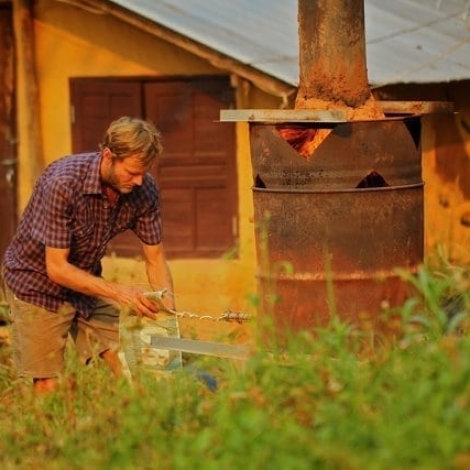Add biochar to a garden or farm to improve the soil’s ability to hold and retain water and increase the crop yield. Biochar can also filter contaminants out of drinking water, including agricultural chemicals that may have leached into the water supply. For more on the benefits and the science of making biochar, please see our article, An ancient filtration material removes pesticides from drinking water.
You make biochar by burning wood at high temperatures in a low-oxygen chamber. The process is similar to making charcoal, except that the biochar material burns at a much higher temperature. The biochar gasifier that we show here burns at 750° – 900°C and can yield 6 to 12kg of char.
This top-lit, updraft gasifier design, including the photos and diagrams, come courtesy of Josh Kearns the science director at Aqueous Solutions, a non-profit water, sanitation and hygiene development organization.
The design is open architecture, so feel free to improve upon it and adapt it to your needs. For questions, and to offer tips and comments, please contact Josh Kearns at josh (at) aqsolutions (dot) org.
For more information, see Aqueous Solutions‘ instructional videos in English and Thai, and downloadable handbooks in English, Thai, Burmese and Spanish.
How to make a 200L (55gal) top-lit updraft gasifier
Materials
*Two 200L (55gal) steel drums
*Square tubular steel or angle iron scrap
*Sheet metal or flue pipe (not tin, aluminum or thin galvanized steel)
*Concrete blocks or bricks or something comparable
*Bolts, nuts, washers
Tools
*Angle grinder
*Drill with bits
*Cold chisel
*Basic welding setup
How to use the gasifier
Pack the reactor full of biomass. That can be any woody or plant-based cellulosic material. Kearns recommends materials such as corn cobs, lumber scrap and coconut husks. For details on what works best, please see the handbook.
Place the crown and chimney on top, then light the biomass through one of the vents in the crown. You can use straw or other kindling, but no lighter fluid or gasoline or anything like that is necessary. As the material pyrolizes (releases and burns off gases) it will burn with an orange flame that you can seen through the vents in the crown, as shown in the photo on the left. When the gases are burned off, the orange flame will fade to a clear, bluish color. At that point, the material is combusting and you need to shut down the reactor before it burns up.
Remove the crown by inserting the poles into the vents and set it aside. This is a two-person job, as you can see in the photo above.
Place the lid on the reactor and, using the handles, move it to a nearby mud pit. Seal the edge of the lid with mud. Wait a couple of hours for it to cool and then enjoy your biochar!
Next: How to Make a Biochar Water Filter
Biochar can be used in water filtration. Aqueous Solutions shows how to make a filter out of a series of drums daisy-chained to supply progressive stages of filtration.


Do you have any videos of the process of using the gasifier? I cannot tell from the description in the article how exactly it happens. It sounds like you pack the reactor (bottom) full of carbonaceous material, but do you light that material or some other combustible in the crown (upper). Also, if char is made by a process devoid of oxygen, why are holes placed in the bottom of the reactor? Wouldn’t this admit oxygen? Sorry for the confusion. I really want to understand this!
Here is a video with some info that hopefully helps….https://vimeo.com/38501679
I’m a mechanical engineering student developing a charcoal retort kiln product and would love to hear feedback from everyone! Responses are anonymous and are super helpful in development. Thanks! Follow this link for the short survey…https://byui.az1.qualtrics.com/jfe/form/SV_3UeARXilukcNRhr